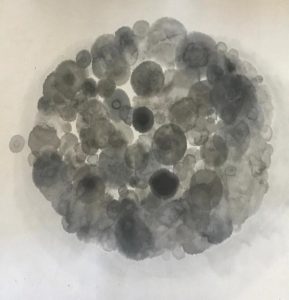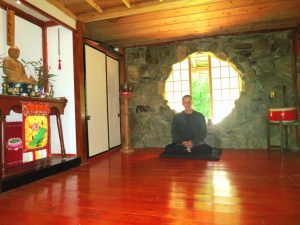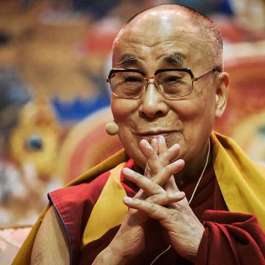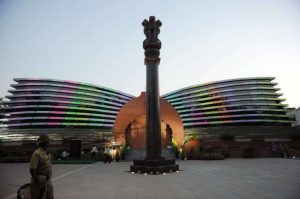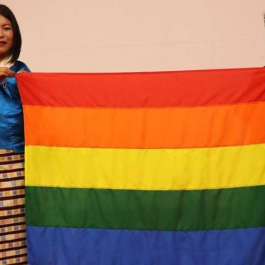
“Neding is held in the arms of Mother Yangri,” the famous yogi Chatral Sangye Dorje Rinpoche once said about his favorite forest hermitage. Nestled in a clearing presided over by a mountain named for the protector goddess Ama Yangri of Yolmo (the indigenous name for Helambu, an area in the southern reaches of the Nepalese Himalaya), it is a meditation retreat in the truest sense. Accessible only by a long uphill walk—one rendered additionally challenging in the monsoon season by hordes of leeches that leap onto intrepid wanderers like miniature, heat-seeking paratroopers, seeking to infiltrate themselves between wet clothes and skin—it has served as a haven for serious practitioners since its inception.
Chatral Rinpoche named this place “The solitary hermitage of excellent Dharma” (Tib: Yang khrod kun bzang chos gling, pronounced Yangtro kunzang choling). To his mind, it was the second Mount Tsari,1 thereby equated with one of the 24 holy places of tantric Buddhism. He had good reason for his esteem: Yolmo is one of 108 “hidden lands” (Tib: sbas-yul, or beyul) blessed by Guru Rinpoche and his consorts, in this case Mandarava. As a result, the valley is latticed with holy sites left by the couple—including several important caves—both known and as yet undiscovered.

Chatral Rinpoche began coming to Yolmo in 1980. In 1988, he inaugurated Neding as a retreat site, leading eight meditators in the traditional three-year retreat. He also bestowed several transmissions to a large audience camped out in the clearing, including the Dzogchen instructions of the Longchen Nyingtig, Dudjom Tersar, Jangter, and Rigdzin Sogdrub,2 along with their empowerments, reading transmission, and oral instructions. More three-year retreats and teachings followed over the years, including instructions on Yeshe Lama and Buddhahood Without Meditation, Düdjom Lingpa’s most widely taught visionary text3 on trekcho.4 He also taught Jigme Lingpa’s Dzogchen Atiyoga manual Yeshe Lama, including the preliminary practice Discerning Samsara and Nirvana.5
The days when crowds of Dharma disciples filled Neding are long gone. Many Dharma followers nowadays dream of going into retreat, but are often only able to occasionally squeeze out a week or two amid their busy schedules. For those, Chatral Rinpoche had stern words of advice, composed in the very retreat place of Neding:
If you don’t reflect on death and impermanence
There will be no way to practice the Dharma purely.
Practice will remain an aspiration
And you may feel regret the day that death comes, but by then it’s too late.6
One of his disciples who took these words of advice to heart is Khentrul Ngawang Lhundrub. In 2013, according to the wishes of both Chatral Rinpoche and his daughter Seymo Saraswati, Khentrul Rinpoche accepted the responsibility of Neding and of preserving Chatral Rinpoche’s legacy. In 2015, two years after he assumed responsibility, Khentrul Rinpoche faced the dual blows of the passing of his teacher and the destruction of nearly all of Neding’s buildings by the earthquake. Nevertheless, he decided to stay on and rebuild.
Apart from Chatral Rinpoche’s meditation cabin—which survived the earthquake—Khentrul Rinpoche has now finished a three-year retreat center, a short-term retreat house for 10 meditators, a lama-house, two individual cabins, two stupas, and a kitchen. He is currently building a memorial stupa and a stone statue of his lama. The three-year retreat under his instruction is in its second generation, with the current batch due to complete their retreat in spring 2025.
Khentrul Rinpoche has now been settled in Neding for more than a decade. He receives day-visitors with a warm welcome and a healthy lunch, generously sharing advice, stories, and meditation instructions according to his visitors’ wishes.
In Neding, the days fall into a sonic rhythm. While the three-year retreatants remain in strict isolation, out of sight from visitors, the sound of their daily pujas form the backdrop of the flow of life at the center. The retreatants start their day at 3 a.m. with chanting and playing the kangling; drumming at five doubles as a signal to visitors to wake for breakfast, and continue throughout day, with a final kangling and changing at 9 p.m. All food at Neding must either be carried in, is grown onsite in a garden and greenhouse, or is foraged from the woods around the clearing. Visitors hoping to explore the forest during the monsoon can expect to become well-acquainted with Yolmo’s other protectors, working alongside Ama Yangri: the armies of leeches, who carry out their duty with gusto.
The leeches, however, are a small price to pay for the stunning, mist-drenched mountain landscape—and for the time and space to delve into practice. Similarly invaluable is the advice, guidance, and conversation of Khentrul Rinpoche. Next year, once the retreatants exit their three-year retreat, Khentrul Rinpoche plans to hold a Troma Nakmo retreat.7 In addition to inviting the local community of ngakpas (lay yogis), he will offer international students the opportunity to learn and practice in retreat. Anyone interested in knowing more about retreat in Neding should inquire at [email protected].
Khentrul Rinpoche has made Yolmo his home, and is familiar with the various caves of Guru Rinpoche. Still, he only wishes to retreat deeper into the forest, just as his lama Chatral Rinpoche used to do. About the hidden land of Yolmo, he says that there is no richer place for meditation practice. “Like opening a secret treasure house, it was as if the Vidyadhara, Garab Dorje, had once again come to the human realm, and excellent fortune appeared again.”8
Julia Stenzel, PhD, is assistant professor and director of studies at Rangjung Yeshe Institute, Kathmandu University, Nepal. [email protected].
Jordan L. Borgman is a second-year MDiv student at Harvard Divinity School focusing on comparative religion and sacred landscapes. [email protected].
1 Khenpo Nyima Dhondruo, Guide to the Hidden Land of Yolmo Snow Enclosure and Its History, Vajra Publications, 27. Tsari (tsa ri), one of the three most important sacred mountains of Tibet, the other two being Kailash and Lapchi (See: https://rywiki.tsadra.org/index.php/Tsari)
2 Tib: rdzog pa chen po klong chen snying thig, bdud ‘djoms gter sar, byang gter, rig ‘dzin srog sgrub.
3 https://wisdomexperience.org/product/buddhahood-without-meditation/: In it, wisdom beings and historical figures in the Great Perfection lineage emphasize the view of cutting through (trekchö) to the original purity of pristine awareness via the four special samayas, or pledges, of the Great Perfection: nonexistence, oneness, uniform pervasiveness, and spontaneous actualization. At each stage of his spiritual progress, Dudjom Lingpa’s doubts are dispelled and his realizations enhanced by pithy advice.
4 Tib. Wyl. khregs chod. Trekcho is translated as “thoroughly cutting through” (resistance, stubbornness, toughness and closed-ness). The practice of trekcho reveals the view of primordial purity beyond conceptual elaboration (kadak trodral).
5 Tib. Wyl: khor ‘das ru shan.
6 Chatral Rinpoche, “Essentail Advice From My Heart,” in The Contemporary Mahasiddha with Many Prophecies,” Dudjom Buddhist Association International, Hong Kong, date unknown.
7 Troma Nakmo (Skt. Krodhakālī; Wyl. khros ma nag mo; Eng. The Black Wrathful Mother). “A feminine embodiment of wisdom. Tröma Nakmo is the innermost secret aspect of the khandro practice in the Dudjom Tersar lineage. The cho practice of Troma Nakmo provides us with an extremely powerful means to cut through the dualistic clinging of mind, the root of suffering, thus revealing our inherent wisdom nature.” See: https://www.rigpawiki.org/index.php?title=Tr%C3%B6ma_Nakmo_(Dudjom)
8 Khentrul Rinpoche, “History of Nehdhing,” unpublished.
See more
Related features from BDG
Rangjung Yeshe Institute and the Future of Buddhist Studies: Insights from Chökyi Nyima Rinpoche and Dr. Thomas Doctor
Buddhism in the Hidden Valley, Part 3: An Interview with Khenpo Karma Samdup on the Legacy of Kenchen Thrangu Rinpoche
Licchavi House, a Refuge for Art, Culture, and the Buddhadharma in Kathmandu






